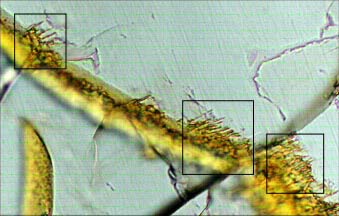Tiny Tunnels in Mars Rock Hint at Possibility of Life

A study of a meteorite that fell in Egypt nearly 95 years ago may offer clues as to the search for possible life on Mars.
Researchers studying the meteorite that originated from Mars found a series of microscopic tunnels within the object that mimic the size, shape and distribution to tracks left on Earth rocks by the feeding frenzy of bacteria.
The discovery of the tiny burrows adds intrigue to the search for life beyond Earth. However, no DNA could be extracted from the meteorite, so it's not known if the tunnels are of biological origin. The scientists said the lack of DNA also does not derail the prospect.
Martin Fisk, a professor of marine geology in the College of Oceanic and Atmospheric Sciences at Oregon State University (OSU) in Corvallis, Oregon is lead author of a study team's research findings, published in the February issue of the bimonthly journal, Astrobiology and announced today.
Bacterial invasion
A focus of their work is the Nakhla meteorite that fell from the sky in 1911 near Nakhla in Egypt. The object was later identified as belonging to an exclusive group of objects known as SNC meteorites-a subgroup of which is the nakhlites-considered to come from the surface of Mars.
Scientists have dated the igneous rock fragment from Nakhla at 1.3 billion years in age. They believe that the rock was exposed to water about 600 million years ago, based on the age of clay found inside the rocks.
Breaking space news, the latest updates on rocket launches, skywatching events and more!
"Virtually all of the tunnel marks on Earth rocks that we have examined were the result of bacterial invasion," Fisk explained in an OSU press statement. "In every instance, we've been able to extract DNA from these Earth rocks, but we have not yet been able to do that with the Martian samples."
That being the case, there are two likely scenarios.
"One is that there is an abiotic [non-living] way to create those tunnels in rock on Earth, and we just haven't found it yet," Fisk said. "The second possibility is that the tunnels on Martian rocks are indeed biological in nature, but the conditions are such on Mars that the DNA was not preserved."
Fisk said it is commonly believed that water is an essential ingredient for life. "So if bacteria laid down the tunnels in the rock when the rock was wet, they may have died 600 million years ago. That may explain why we can't find DNA-it is an organic compound that can break down."
Handful of environments
How do scientists know that the meteorite came from the red planet in the first place?
Nakhla is one of more than 30 meteorites identified as coming from Mars, hurled off that planet due to asteroid or comet impacts long ago. Eventually, after tumbling through space, a few crossed Earth's orbit and came to full-stop on our planet.
The SNC meteorites contain gas trapped in their interiors. The composition of this gas has been found to be nearly identical to that of the atmosphere on the red planet, as measured by NASA's twin Viking Mars landers in 1976.
The igneous rocks from Mars are similar to many of those found on Earth, and virtually identical to those found in a handful of environments, including a volcanic field in Canada.
Scientists have come across rock-eating microbes here on Earth in a wide assortment of places-below the ocean floor, in desert settings, and on dry mountaintops, Fisk and his colleagues point out.
A follow-on question that the OSU researchers hope to answer is whether bacteria begin devouring the rock as soon as they are introduced. Such a discovery might help estimate when water-and possibly life-may have been introduced on Mars.
Along with Fisk, other authors on the Astrobiology paper include Olivia Mason, an OSU graduate student; Radu Popa, of Portland State University; Michael Storrie-Lombardi, of the Kinohi Institute in Pasadena, Calif.; and Edward Vicenci, from the Smithsonian Institution.
Old claim, new data
In other Mars meteorite research, an international team of scientists will fuel more debate about the 1996 NASA-led assertion that another Martian meteorite-Allan Hills 84001, or ALH 84001-contained tell-tale signs of past biological activity on Mars.
The claim centered on whether organic compounds and tiny globules of carbonate minerals imbedded in that meteorite may have been processed by Martian biology. Indeed, the tiny carbonate globules from the meteorite seem to resemble minerals that arise from microbial activity on Earth.
But a fresh take on this issue will show that such carbon complexes in ALH 84001 likely formed by non-biological processing on Mars, according to Andrew Steele of Carnegie Institution's Geophysical Laboratory in Washington, D.C.
The new ALH 84001 research is to be presented at NASA's Astrobiology Science Conference (AbSciCon) 2006 being held March 26-30 in Washington, D.C.
Join our Space Forums to keep talking space on the latest missions, night sky and more! And if you have a news tip, correction or comment, let us know at: community@space.com.

Leonard David is an award-winning space journalist who has been reporting on space activities for more than 50 years. Currently writing as Space.com's Space Insider Columnist among his other projects, Leonard has authored numerous books on space exploration, Mars missions and more, with his latest being "Moon Rush: The New Space Race" published in 2019 by National Geographic. He also wrote "Mars: Our Future on the Red Planet" released in 2016 by National Geographic. Leonard has served as a correspondent for SpaceNews, Scientific American and Aerospace America for the AIAA. He has received many awards, including the first Ordway Award for Sustained Excellence in Spaceflight History in 2015 at the AAS Wernher von Braun Memorial Symposium. You can find out Leonard's latest project at his website and on Twitter.
